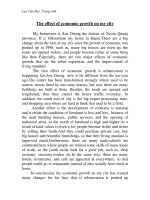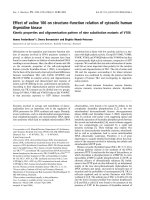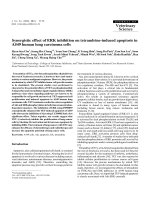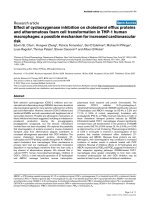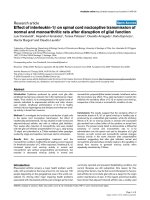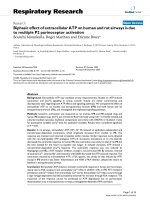Effect of bolus osmolality on human esophageal function
Bạn đang xem bản rút gọn của tài liệu. Xem và tải ngay bản đầy đủ của tài liệu tại đây (268.08 KB, 4 trang )
0002-9270/89/8406-0611
THE AMERICAN JOURNAL OF GASTROENTEROLOGY
Copyright© 1989 by Am. Coll. of Gastroenterology
Vol. 84, No. 6, 1989
Printed in U.S.A.
Effect of Bolus Osmolality on Human Esophageal Function
Claudio R. Bilder, M.D., Cornelius P. Dooley, M.D., M.R.C.P.I., and Jorge E. Valenzuela, M.D., F.A.C.G.
Section of Gastroenterology, Department ofMedicine, VSC School of Medicine, Los Angeles, California
The effect of bolus osmolality on human esophageal
function is undefined. We sought to define the response
of the human esophagus to boluses with a wide range
of osmolalities in 10 healthy male volunteers. Intraluminal pressure events were measured with an infused
catheter system, and lower esophageal sphincter pressure was monitored continuously with a Dent sleeve.
Each subject was given a series of 10 swallows of each
of seven boluses, which consisted of water, mannitol
solutions with osmolalities of 142, 296, 449, 704, and
1481 mOsm/kg, and orange juice (585 mOsm/kg), in a
randomized fashion. Tracings were coded and analyzed
blindly. Alterations in bolus osmolality did not elicit
any significant changes in amplitude and duration of
contraction, velocity of wave propagation, or the duration of relaxation of the lower esophageal sphincter.
We conclude that bolus osmolality does not play a
significant role in the control of human esophageal
motility, and that this lack of effect is explained by
consideration of esophageal muscle mechanics.
INTRODUCTION
The esophagus utilizes a complex and highly coordinated pattern of neuromuscular activity to convey
ingested food and saliva to the stomach. Certain bolus
attributes, such as volume (1, 2), viscosity (3), and
temperature (4, 5), are known to have a significant
modulating influence on esophageal peristalsis. The
effect of bolus osmolality on human esophageal function has not been documented, although many important functions in the upper gastrointestinal tract are
mediated through osmoreceptors (6, 7). The current
study sought to document the response of the human
esophagus to alterations in bolus osmolality.
MATERIALS AND METHODS
Subjects
Ten normal male volunteers without any evidence of
gastrointestinal and esophageal disease were included
in this study. Their ages ranged from 29 to 66 yr (mean
± SD 44 ± 11 yr), and all subjects gave fully informed
Received January 10. 1989; revised February 14, 1989; accepted
February 16, 1989.
611
consent under a protocol approved by this institution's
research committee.
Esophageal manometry
Esophageal manometry was performed with a sixlumen manometric assembly that had four esophageal
body recording sites radially oriented, a 6-cm sleeve
(Dent) device for continuous recording of lower esophageal sphincter pressure, and a gastric side-hole recording site at the distal end of the sleeve sensor. The distal
esophageal side hole was located at the proximal border
of the sleeve device, and the next esophageal sensor was
located 3 cm proximally. The two remaining esophageal
body recording sites were each located at 6-cm intervals
proximally. The catheters were continuously perfused
with gas-free water by a low-compliance pneumohydraulic infusion pump (Amdorfer Medical Specialities
Inc, Greendale, WI) at a rate of 0.5 ml/min. Resistance
to infusion within the system was detected by a series
of external transducers (Statham P23DB, Statham Inc,
Oxnard, CA) positioned at the intersection of the costal
margin and mid-axillary line of the subject. Sudden
occlusion of each orifice resulted in a pressure rise in
excess of 300 mm Hg/sec. Pressure profiles were displayed on a multichannel polygraph recorder (Beekman
R611, Beekman Instruments Inc, Fullerton, CA). The
recording assembly was passed orally and positioned
with all recording orifices in the stomach. Baseline
pressures were set at intragastric pressure. A station
pull-through was performed to locate the lower esophageal sphincter accurately. The assembly then was taped
in position with the sleeve device straddling the sphincter. The resulting position located the distal esophageal
sensor 3 cm above the midpoint of the sphincter (8).
All studies were performed with the assembly in this
position and the subjects supine.
Study design
All subjects were studied after a minimum 6-h fast.
Once the manometric assembly was positioned correctly, the subject was given a series of 10 swallows
(each 5 ml) of water, a number of mannitol solutions,
and orange juice. The mannitol solutions were 5% (142
mOsm/kg), 10% (296 mOsm/kg), 15% (449 mOsm/
kg), 20% (704 mOsm/kg), and 25% (1481 mOsm/kg).
612
Vol. 84, No. 6, 1989
BILDER et al.
The corresponding osmolalities of water and orange
juice were 1 mOsm/kg and 585 mOsm/kg. The order
of each set of swallows was randomized, and all boluses
were given at room temperature (23-26°C). All swallows were separated by at least 30 s, and an event
marker was used to denote each swallow event. If a
second swallow was incidentally initiated within 20 s
of the primary event, both swallows were excluded from
the subsequent analysis.
Analysis of data
Individual tracings were coded and analyzed in a
blinded fashion for peristaltic wave amplitude and duration, propagation velocity of peristaltic contractions,
and duration of lower esophageal sphincter relaxation,
as previously described (3, 8). For each subject, peristaltic parameters for each set of swallows were averaged
to give individual means. Mean values for the group of
subjects thus represent the mean of the individual
means (1). Data analysis was performed with ANOVA
with p values of 0.05 being considered significant.
RESULTS
We were unable to demonstrate any significant alterations in the parameters of esophageal peristaltic function during deglutition of the boluses of varying osmolality. Specifically, wave velocity (Table 1), amplitude of contraction (Table 2), and wave duration (Table
3) did not vary significantly with any of the boluses. In
addition, the frequency of peristalsis did not differ
between the boluses, being >90% in all cases. Further,
the duration of relaxation of the lower esophageal
sphincter did not change significantly with any of the
boluses utilized in the study (range, 7.3 ± 1.9 sto 8.8
± 2.9 s). No alterations in the frequency of nonspecific
motor abnormalities was noted with any of the boluses.
DISCUSSION
The characteristics of the swallowed bolus have a
significant role in determining the physiological reTABLE 1
Effects ofAlterations in Botus Osmotatity on Velocity of Propagation
(cm/sec) of the Peristattic Wave
Esophageal Segtnent"
Water
Mannitol 5%
Mannitol 10%
Mannitol 15%
Mannitol 20%
Mannitol 25%
Orange juice
18-12 cm
12-6 cm
6-3 cm
3.4 ± 1.1
3.2 ± 1.3
2.8 ± 0.7
3.8 ± 2
2.9 ± 0.7
3.2 ± 1.1
2.9 ± 1.2
1.8 ±0.4
1.8 ±0.3
2 ±0.5
1.9 ± 0.4
1.9 ±0.4
2.1 ±0.4
1.9 ±0.4
.7±
.8 ±
.8 ±
.8±
.6 ±
.7 ±
.6 ±
1.3
0.9
0.9
1
0.9
0.9
0.6
Values are mean ± SD.
* Refers to segment position above midpoint of lower esophageal
sphincter.
TABLE 2
Effect ofAlterations in Bolus Osmolatity on Amplitude of
Contraction (mm Hg)
Esophageal Sensor Position*
Water
Mannitol 5%
Mannitol 10%
Mannitol 15%
Mannitol 20%
Mannitol 25%
Orange juice
\i i cm
12 ctn
6 cm
49 ±31
48 ±32
48 ±32
49 ±27
46 ±31
46 ±26
41 ±30
91 ± 4 5
88 ± 51
88 ±42
94 ± 5 3
88 ±50
82 ± 5 5
109 ± 6 2
123 ± 86
119± 58
123 ± 78
113± 69
121 ± 84
113± 84
78 ±46
3 cm
61
62
65
63
68
65
67
±31
±34
±44
±36
±38
±41
±42
Values are mean ±SD.
* Refers to sensor position above; midpoint of lower esophageal
sphincter.
TABLE 3
Effect of Alterations in Bolus Osmolatity on Duration of Contraction
(s)
Esophageal Sensor Position*
Water
Mannitol 5%
Mannitol 10%
Mannitol 15%
Mannitol 20%
Mannitol 25%
Orange juice
IS cm
12 cm
5.6 ± 1.6
5.3 ± 1.2
5.5 ±0.9
4.9 ± 1.3
4.9 ±0.9
5.1 ± 1.3
5.6 ± 2
5.7 ± 1
6 ± 1.1
5.9 ± 1.4
5.6 ± 1.3
5.6 ± 1.3
5.4 ± 1.4
5.7 ± 1.3
6 cnrI
6.1 ±
6±
6.2 ±
5.8 ±
6±
5.4 ±
6±
3 cm
.3
.1
.4
.2
.3
.2
.4
5.4 ±
5.8 ±
5.7 ±
5.2 ±
5.6 ±
5.7 ±
5.8 ±
0.4
0.4
0.9
0.9
0.9
0.9
0.8
Values are mean ± SD.
* Refers to sensor position above midpoint of lower esophageal
sphincter.
sponse of the esophagus to deglutition. In particular,
bolus volume (1, 2), viscosity (3), and consistency (9)
have incremental effects on the parameters of esophageal peristalsis as the bolus is changed progressively
from a "dry swallow" through water to a highly viscous
liquid or a solid. Humans commonly drink liquids of
high osmolality, but it is not known whether bolus
osmolality modulates esophageal function. Nasrallah
and Hendrix (10) reported that a hypertonic glucose
solution had no significant effects on the amplitude of
esophageal contractions in 16 asymptomatic volunteers. However, esophageal contraction amplitude is
not affected by alterations in many bolus attributes (3,
9), and we felt it necessary to make a closer study of
the effects of an osmolar stimulus before accepting the
conclusions of the previous study (10). Our study confirms these data and expands on the previous study by
documenting lack of effect on all other parameters of
esophageal peristalsis and by examining boluses of
widely varying osmolality.
This lack of response of the esophagus to an osmolar
stimulus is not unexpected. Factors that have a modulating infiuence on esophageal peristalsis do so through
alterations in resting esophageal muscle length or
June 1989
BOLUS OSMOLALITY AND ESOPHAGEAL MOTILITY
stretch (preload) and/or the mass that the esophageal
muscle moves during contraction (11). The effect of
bolus viscosity appears to be mediated through alterations in both preload and afterload (3), whereas the
effect of body position may be mediated through alterations in afterload (12). Altering the osmolality of ingested liquids does not change the physical cohesiveness
of the bolus and, thus, neither preload nor afterload is
affected. The lack of utility of hypertonic glucose as a
provocative test in patients with noncardiac chest pain
(10) also is explained by these considerations; the osmolar stimulus does not stress the esophageal musculature.
In summary, then, we have found that bolus osmolality does not have a role in the control of human
esophageal peristalsis, and that this lack of effect is
explained by consideration of esophageal muscle mechanics.
ACKNOWLEDGMENT
The authors express their gratitude to Charito
Ocampo for expert technical assistance.
Reprint requests: Cornelius P. Dooley, M.D., Section of Gastroenterology, Department of Medicine, USC: School of Medicine, 2025
Zonal Avenue, Los Angeles, CA 90033.
613
REFERENCES
1. Hollis JB, Castell DO. Effect of dry swallows and wet swallows
of different volumes on esophageal peristalsis. J AppI Physiol
1975;37:378-83.
2. Vaneck AW, Diamant NE. Responses of the human esophagus
to paired swallows. Gastroenterology 1987;92:643-50.
3. Dooley CP, Schlossmacher B, Valenzuela JE. Effects of alterations in bolus viscosity on esophageal peristalsis in humans. Am
J Physiol 1988;254:G8-11.
4. Winship DH, Viegas de Andrade SR, Zboralske FF. Influence of
bolus temperature on esophageal motor function. J Clin Invest
1970;49:243-50.
5. Kaye MD, Kilby AE, Harper PC. Changes in distal esophageal
function in response to cooling. Dig Dis Sci 1987;32:22-7.
6. Dooley CP, Valenzuela JE. Duodenal volume and osmoreceptors
in the stimulation of human pancreatic secretion. Gastroenterology 1984;86:23-7.
7. Meeroff JC, Go VLW, Phillips SF. Control of gastric emptying
by osmolality of duodenal contents in man. Gastroenterology
1975;68:1144-51.
8. Kahrilas PJ, Dodds WJ, Hogan WJ, et al. Esophageal peristaltic
dysfunction in peptic esophagitis. Gastroenterology 1986;91:897904.
9. Dooley CP, Di Lorenzo C, Valenzuela JE. Modulation of esophageal peristalsis in humans by alterations in bolus consistency.
Gastroenterology 1988;95:862 (abstract).
10. Nasrallah SM, Hendrix EA. Comparison of hypertonic glucose
to other provocative tests in patients with noncardiac chest pain.
Am J Gastroenterol 1987;82:406-9.
11. Cohen S, Green F. The mechanics of esophageal muscle contraction. Evidence of an inotropic effect of gastrin. J Clin Invest
1973;52:2029-40.
12. Dooley CP, Schlossmacher B, Valenzuela JE. Modulation of
esophageal peristalsis by alterations of body position: effect of
bolus viscosity. Dig Dis Sci (in press).
